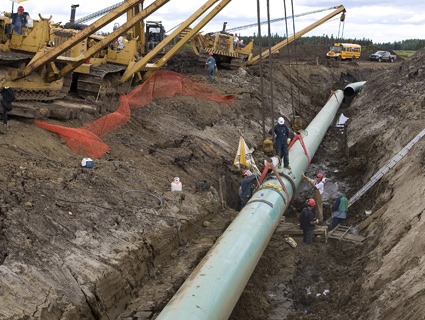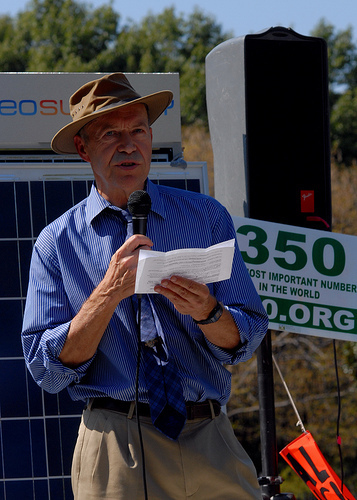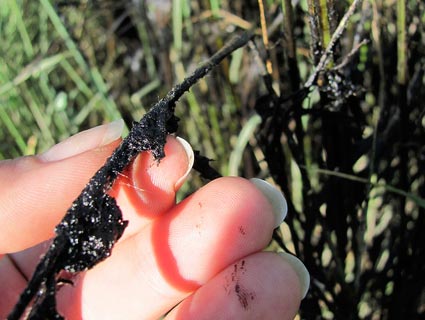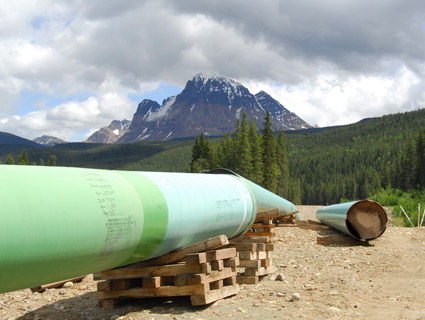
Construction on the existing Keystone pipeline.Imago/ZUMA
Hundreds of activists have arrived in Washington, DC, to protest the proposed Keystone XL project, a 1,661-mile pipeline that would carry oil from Canada’s tar sands to refineries in Texas. If TransCanada gets the green light from the Obama administration, the pipeline would carry as much as 900,000 barrels of oil every day—oil with a carbon output 20 percent higher than conventional oil supplies.
The State Department is expected to release a final environmental impact statement on the proposal this month and issue a decision by the end of the year. The looming ruling has prompted activists to organize two weeks of protests at the White House—with several thousand expected to risk arrest.
Since the action began on Saturday, 212 people have been arrested outside of the White House. The majority have been processed and released, though some of the higher-profile activists were kept from Saturday through Monday morning, a move they believe was made to deter further protests. Writer and activist Bill McKibben (also a Mother Jones contributor), lawyer and environmental leader Gus Speth, and LGBT-rights activist Lt. Dan Choi were among those kept in jail.
The protesters have arrived outside the White House each morning, with a group of volunteers agreeing to sit in until they are arrested each day. Organizers estimate that between 50 and 100 people will be arrested every day, with the biggest day of action planned for Saturday, August 27. Spokesman Jamie Henn, of the group 350.org, said that 2,000 people have signed up to participate. They plan to continue the protest through Labor Day.
Because many of you may be wondering what the heck is going on with the protests, we’ve compiled this backgrounder. But I’m sure none of you need it, since you’ve been following our coverage of the Keystone XL all along. Right?
What is the Keystone XL? The Canadian energy company TransCanada has asked for permission to build a 1,661-mile pipeline that would travel from Hardisty, Alberta, down to oil refineries in Houston and Port Arthur, Texas. It would supplement the existing Keystone pipeline, which went into operation last summer and can carry up to 435,000 barrels of oil per day. The pipeline would carry tar sands oil, which is heavier, more carbon-intensive, and more corrosive than conventional oil. It is scheduled for completion in 2013, though it would not hit capacity until 2056.
What’s wrong with building a giant pipeline across the US? That existing Keystone line has already leaked a dozen times in just one year of operation. The Keystone XL would cross more than 70 rivers and streams, including the Missouri, Platte, Yellowstone, and Arkansas. The oil spill from another pipeline in the Yellowstone River last month didn’t do much to allay those concerns. It would also cross the Ogallala Aquifer, which provides nearly one-third of the groundwater used to irrigate US crops, supports $20 billion in agriculture, and supplies drinking water to about 2 million people. A recent report from a researcher at the University of Nebraska estimated that there would be 91 significant spills from the pipeline in the next 50 years. A worst-case-scenario spill in Nebraska’s sand hills above the Ogallala Aquifer could dump as much as 180,000 barrels, tainting the vast water supply in the region.
The much-higher carbon footprint of tar sands oil and its contribution to climate change are also concerns, as are the health problems reported near extraction sites.
Who is opposed to building the pipeline? Environmental groups, landowners along the path of the pipeline (especially those threatened with eminent domain), the National Farmers Union, climate scientists, a number of senators (including both the Republican and Democratic senators from Nebraska), the Transport Workers Union, and the Amalgamated Transit Union have all urged the State Department to veto the plan.
Who supports building it? TransCanada, of course, as well as the oil companies that plan to ship oil through it, the American Petroleum Institute, the Teamsters Union, the US Chamber of Commerce, and the members of the House that voted for a bill that would expedite consideration of the plan.
How does the Keystone XL compare in size to other oil pipelines? If constructed, it would certainly be among the longest pipelines in the United States. But there are longer ones, like the 1,679-mile Rockies Express natural gas pipeline from Colorado to Ohio or the 1,900-mile Lakehead System from North Dakota to Michigan.
But won’t the pipeline create tons of jobs? API refining issues manager Cindy Schild claimed in a press call last week that the pipeline would directly create 20,000 new jobs, and spur the creation of as many as 80,000 more jobs in the United States related to tar sands development. TransCanada’s own projection on job growth has ballooned in the past few years, from initial predictions of 13,000 to now 20,000. But most of those jobs would be short-term, lasting for just the two years expected to take to complete the pipeline.
Why does the State Department get to decide whether to build it? Because the pipeline crosses an international border. The State Department is required, however, to ask other federal agencies to weigh in. Last year, the Environmental Protection Agency gave a failing grade to State’s initial environmental-impact analysis. State issued a new draft in April and is expected to issue a final version later this month. After that, they plan to hold public meetings in September.
Where will all that oil go? That’s a good question! Supporters argue that getting oil from our friendly neighbors up north is preferable to getting it from Middle Eastern countries that don’t like us very much. But our oil demand is expected to decline anyway. And since it would be pumped down to ports in Texas, it can easily be shipped to other countries in Europe or Asia, a concern that critics have raised.
What does President Obama think about the pipeline? That’s another good question! It’s also the reason the protesters plan to be out there for the next few weeks. They’re hoping that the actions will put pressure on Obama, who has so far been pretty quiet on the subject, to weigh in against the pipeline. Obama may be in Martha’s Vineyard right now, but the protesters will be waiting for him when he returns to the White House.
We already have a ton of pipelines, so why do activists care so much about this one? Well, unlike most major environmental issues, President Obama doesn’t need Congress to do anything here. The decision is entirely within the control of his administration. For protesters, this is also symbolic; if Obama wants to show that he still cares about climate change, he could veto this project, they argue. Environmental groups are also hoping for a concrete victory. Even with a supposedly sympathetic president, they haven’t seen the big policy shifts on this front that they were hoping for. And while addressing climate change is a giant, complicated challenge, vetoing a pipeline is fairly straightforward.














